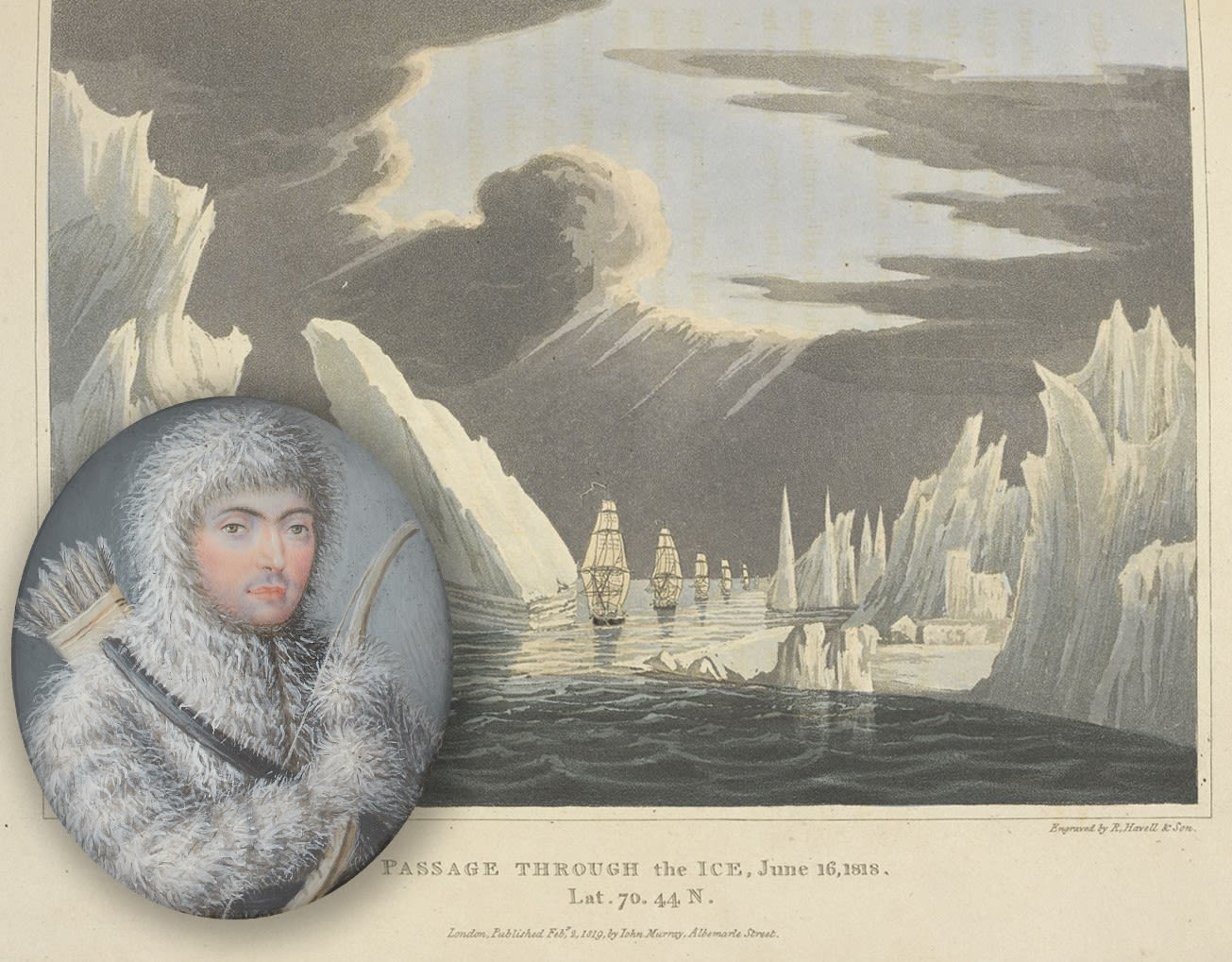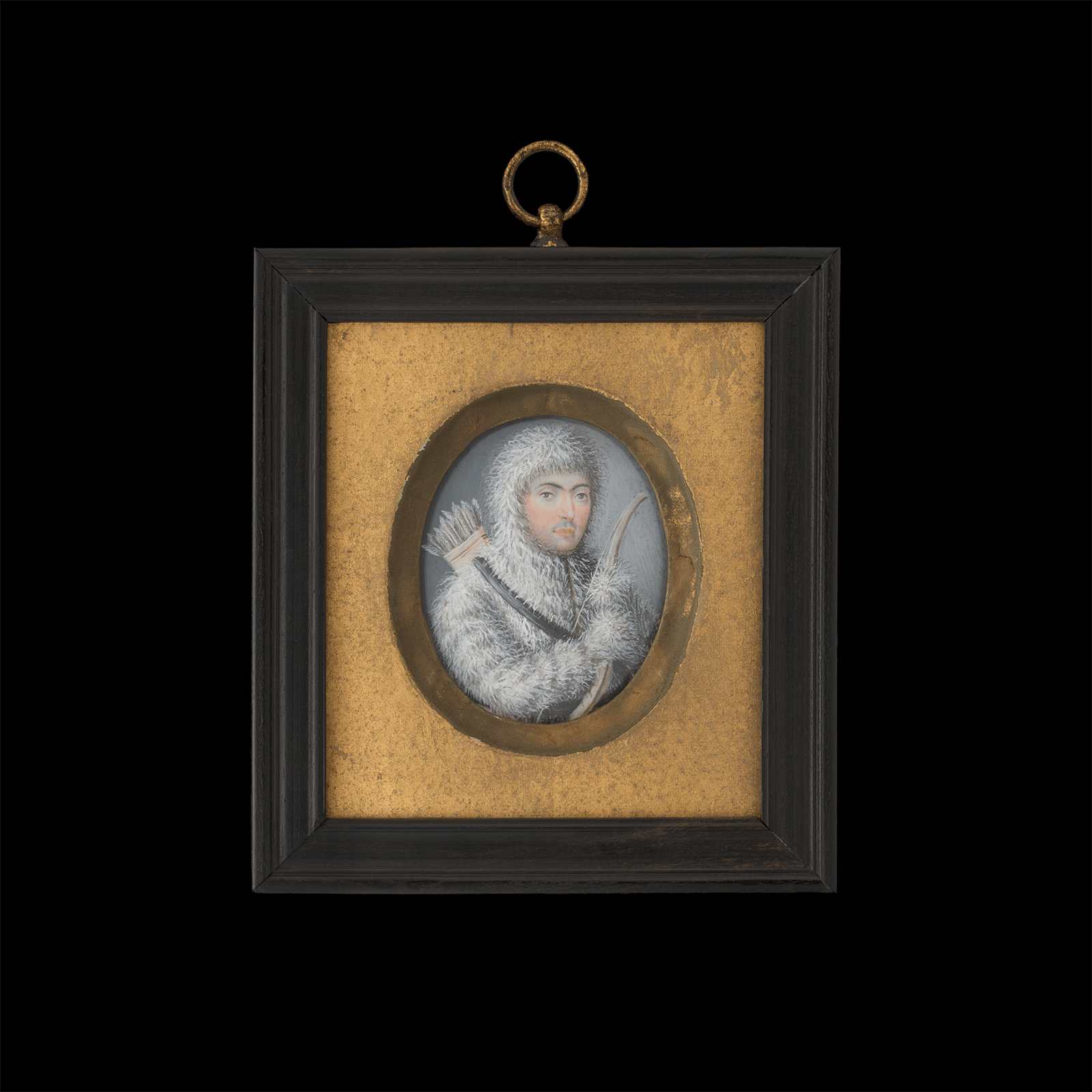'Not many people have long stories—only short stories. Little stories, here and there. We don’t know much at all.' - Dorothy Harley Eber, Encounters on the Passage: Inuit Meet the Explorers. Toronto: University of Toronto Press, 2008.
Cold Case: An Inuit Mystery
By Emma Rutherford (Portrait Miniatures Consultant)
During lockdown our heads were turned by the appearance at auction of a most unusual portrait miniature of a man wearing a fur parka, bundled up against Arctic levels of cold, his hunting equipment to hand [Fig. 1]. Further research has shown this image to be wholly unique in the medium of the portrait miniature and extremely rare in any form of portraiture.
From a portrait miniature perspective, it was clear to me, and to other specialists who saw it, that it was painted by an artist in the first quarter of the 19th century. The distinctive grey background and the application of the watercolour strokes were also consistent with the work of artists whose training was in France. But how had a French-trained artist had access to someone dressed in Arctic garb? And why were they painted in this way? And more importantly, who was the man in this intriguing small portrait?
One area that we looked at closely was Canada, as many emigrating French citizens were drawn to 'New France', as part of this land was once called. 'New France' consisted of five colonies that covered a huge swath of North America, stretching from Hudson Bay in the north to the Gulf of Mexico in the south. French artists were among settlers there, made comfortable by the dominance of their native language spoken in provinces and cities such as Quebec and Montreal. Quebec also shares maritime borders with Nunavut, Prince Edward Island and Nova Scotia, where a fur parka like the one worn by our sitter would have been essential winter attire.
During our research, we spoke to several curators working on projects connected to the history of the Arctic. We explored whether our mysterious sitter might have been connected to Denmark, Russia or Alaska. The answers kept returning that this image appeared to have no precedent. Frustratingly, there were also few clues as to whether the sitter was Indigenous or European. After careful consideration of both possibilities, and sifting through dozens of prints and drawings, the main clue as to his identity seemed to be the bow and arrow he holds. As European hunters and fur traders used rifles from the mid-17th century, it seemed unlikely that a European would be portrayed with traditional hunting equipment. It was during this research that an image of an Inuk man emerged, connected to the search for a Northwest Passage largely promoted by John Barrow, Second Secretary of the Admiralty from 1804 to 1845.
Entitled 'Inuk with a bow and arrow, Arctic', this illustration by an unknown hand [fig. 2] portrays a person in similar garb to the miniature, with the rounded bonnet-hood and parka with front opening. They also hold a bow and arrow.
The other images which appeared to share an affiliation with the enigmatic miniature portrait were those painted in the sketchbooks of Robert Hood (c. 1797-1821), who joined John Franklin's Coppermine Expedition of 1819-22. His watercolours of the Inuit interpreters from Churchill employed by the North Land Expedition, show the [Fig. 3] carefully observed features of the men; like our sitter, they have both grown a faint moustache but wear European clothing.
Hood’s portraits, like the present miniature, are highly individualised. It is tempting to assume that the artist painting the miniature knew the sitter well, as in tone it sits well-apart from the detached anthropological studies such as that in Barrow’s book (fig. 2). In fact, it is possible that this portrait miniature records the respect duly afforded to Indigenous explorers of the Northwest Passage and other areas of the Arctic. Many European explorers noted the often-overlooked debt to the Indigenous people who shared their knowledge in surveying their vast unchartered land. In this part of the world, where nature is at its most hostile, such interaction could have been the difference between life and death.
Emma Rutherford, consultant, Portrait Miniatures
November 2020
For more information on this portrait, please see our catalogue entry here.
With thanks to the time given by the many curators and specialists in researching this portrait, especially those at The British Museum, where the current exhibition looks at the enduring culture and resilience of Indigenous Peoples in the Arctic. Tickets can be booked here.


![[Fig. 2] Inuk with a bow and arrow, Arctic, illustration from A chronological history of voyages into the Arctic Regions, by John Barrow, Milan, Sonzogno, 1820.](https://artlogic-res.cloudinary.com/w_1600,h_1600,c_limit,f_auto,fl_lossy,q_auto:good/ws-philipmould/usr/exhibitions/images/feature_panels/321/eskimo-with-a-bow-and-arrow.jpg)


